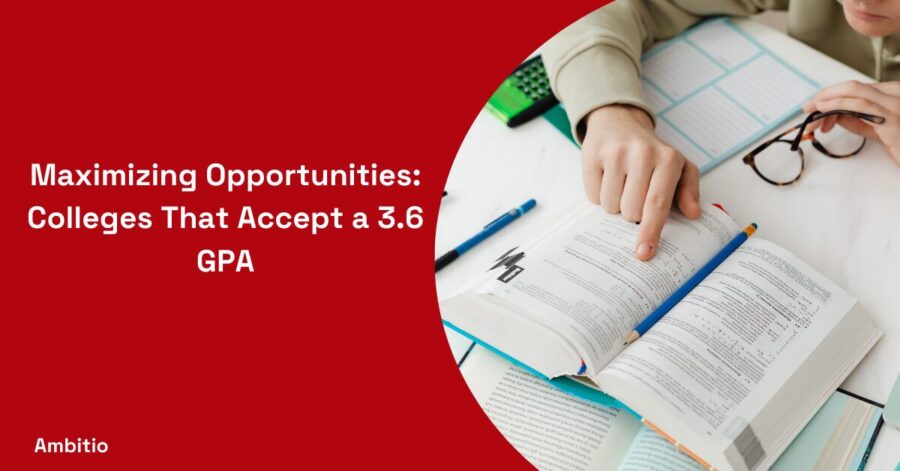13 December 2024
7 minutes read
Maximizing Opportunities: Colleges That Accept a 3.6 GPA

Understanding the Value of a 3.6 GPA in College Admissions
A 3.6 GPA, which typically ranges between an ‘A-‘ and a ‘B+’ average, is often regarded as a strong academic performance indicator. It’s important to understand how this GPA can impact your college admissions journey.
What Does a 3.6 GPA Mean in the College Admissions Landscape?
A GPA of 3.6 signifies that a student consistently achieves above-average grades, placing them in a good position for college admissions. This GPA is considered above the national average GPA for high school students, which can be a significant advantage in the competitive college admissions process.
Holistic Admissions and the 3.6 GPA Student
In the holistic admissions process, colleges consider the entire profile of an applicant, not just their academic scores. This means a student with a 3.6 GPA has the opportunity to showcase other strengths, such as leadership roles, community service, extracurricular activities, and personal essays. These components allow students to present a well-rounded picture of who they are beyond their academic achievements.
For a student with a 3.6 GPA, it’s essential to highlight unique experiences and personal qualities. For example, leadership roles in school clubs, participation in sports teams, involvement in community service, or part-time work can significantly enhance an application.
These experiences demonstrate qualities like responsibility, time management, teamwork, and a commitment to the community, which are highly valued by colleges.
Additionally, personal essays offer a chance to narrate your unique story, challenges you’ve overcome, and goals for the future. A well-crafted essay can significantly impact the admissions decision, providing context to your GPA and showcasing your personality and potential.
Identifying Colleges That Fit Your Profile
When looking for colleges that accept a 3.6 GPA, it’s crucial to consider how well each college aligns with your academic and personal goals. Start by researching colleges known for programs that interest you. Many colleges and universities, both public and private, are well-suited for students with a 3.6 GPA, offering a range of programs and opportunities.
Utilize college search tools and visit college websites to gather information about their average admitted GPA, admission requirements, and the programs they offer. Attending college fairs, speaking with admissions representatives, and visiting campuses (if possible) can provide valuable insights.
It’s also important to consider the overall environment of the college. Think about the size of the school, location, campus culture, and extracurricular opportunities. These factors can significantly impact your college experience.
Expanding on the GPA Scale and Its Implications
The GPA (Grade Point Average) scale is a standard way of measuring academic achievement in the U.S. Typically, it ranges from 0 to 4.0, with a 4.0 representing perfect grades. A 3.6 GPA indicates that a student has mostly A’s and high B’s, which is a clear sign of academic dedication and capability.
Colleges often use GPA as a metric to assess a student’s readiness for the rigors of college-level work. A 3.6 GPA shows that a student can handle challenging courses and is likely to succeed in a college environment.
However, it’s important to note that GPA standards can vary between different high schools. Some schools may have a weighted GPA system that gives additional points for advanced placement (AP) or honors classes, potentially affecting how colleges interpret a 3.6 GPA.
Building a Strong Application Portfolio
Creating a compelling college application portfolio is crucial for showcasing your strengths and standing out in the college admissions process. For students with a 3.6 GPA, a well-rounded and thoughtfully prepared portfolio can make a significant difference. Here are key points to consider:
Academic Achievements
- Highlighting Your GPA: Clearly showcase your 3.6 GPA and the consistent effort it represents.
- Course Rigor: Include information about any advanced or challenging courses you’ve taken, such as AP or honors classes, to demonstrate academic rigor.
- Academic Awards and Honors: List any academic awards or recognitions you’ve received, as they underscore your commitment to academic excellence.
Standardized Test Scores
- SAT/ACT Scores: If you have strong SAT or ACT scores, make sure to include them, especially if they complement your GPA.
- Subject Tests or AP Exams: Scores from these tests can highlight your proficiency in specific subject areas.
Extracurricular Activities
- Leadership Roles: Detail any leadership positions you’ve held in clubs, sports teams, or other organizations.
- Community Involvement: Showcase your participation in community service or volunteer work, emphasizing any long-term commitments or significant projects.
- Hobbies and Interests: Include hobbies or interests that demonstrate a well-rounded personality, such as music, art, coding, or writing.
Personal Statement and Essays
- Narrative of Growth: Use your personal statement to tell a story of personal growth, challenges overcome, or unique experiences that have shaped you.
- Connection to Goals: Articulate how your experiences align with your future goals and the reasons for choosing your intended field of study.
Letters of Recommendation
- Teacher Recommendations: Secure letters from teachers who know you well and can speak to your academic abilities and character.
- Additional References: Consider including recommendations from coaches, employers, or community leaders who can vouch for your skills and contributions outside of academics.
Additional Components
- Work Experience: Include any part-time jobs or internships, highlighting responsibilities and skills gained.
- Special Projects or Research: Mention any independent projects, research work, or significant class assignments that showcase your initiative and intellectual curiosity.
Tips for a Strong Portfolio
- Consistency and Clarity: Ensure your portfolio is well-organized and each component clearly contributes to your overall narrative.
- Personalization for Each College: Tailor aspects of your portfolio to align with the specific colleges to which you are applying, reflecting their values and priorities.
- Proofreading and Feedback: Have your portfolio reviewed by teachers, counselors, or mentors for feedback and to catch any errors.
By focusing on these aspects, students with a 3.6 GPA can build a strong and impactful application portfolio, highlighting their strengths and potential to succeed in college and beyond.
Balancing GPA with SAT/ACT Scores
For students with a 3.6 GPA, achieving strong standardized test scores can be an effective way to bolster their college applications. Colleges often use SAT or ACT scores in conjunction with GPA to assess a student’s academic readiness.
Preparing thoroughly for these tests is crucial. Consider taking practice tests, enrolling in preparation courses, or working with a tutor to improve your performance. A high SAT or ACT score can complement your GPA and showcase your academic abilities in a standardized context.
It’s also important to understand the testing policies of the colleges you’re interested in. Some colleges may be test-optional, meaning they do not require SAT or ACT scores for admission. In such cases, your GPA and other aspects of your application will carry more weight.
Scholarship Opportunities and Financial Aid
Understanding and navigating the scholarship and financial aid landscape can greatly alleviate the financial burden of college education. For students with a 3.6 GPA, several opportunities are available:
Scholarships Based on Academic Merit
- Merit-based Scholarships: Many colleges offer merit-based scholarships for students who have demonstrated academic excellence. A 3.6 GPA often qualifies for these scholarships, which can cover a portion or even the full cost of tuition.
- Departmental Scholarships: Specific academic departments may offer scholarships for excellence in particular fields of study. Research departments in your intended major to discover available opportunities.
- Performance-based Awards: Aside from GPA, scholarships may be available for achievements in areas like arts, sports, or community service.
External Scholarships
- Local Community Scholarships: Check with local businesses, community organizations, and foundations, as they often sponsor scholarships for residents.
- National Scholarships: Organizations across the country offer scholarships for various achievements and backgrounds. Websites like Fastweb and Scholarships.com can be useful resources for finding these opportunities.
- Industry-Specific Scholarships: Corporations and professional associations often provide scholarships for students pursuing careers in specific industries, such as engineering, healthcare, or technology.
Financial Aid Options
- Federal Grants and Loans: Completing the Free Application for Federal Student Aid (FAFSA) can qualify you for federal grants, loans, and work-study programs. Grants, unlike loans, do not need to be repaid.
- State Grants: Many states offer their own grant programs for residents attending college. These are often need-based and require a FAFSA submission.
- Institutional Aid: Many colleges provide their own financial aid packages. This aid can be need-based or merit-based and may cover a significant portion of tuition and living expenses.
Tips for Maximizing Financial Opportunities
- Apply Early: Many scholarships and grants have early deadlines. Start your search early and keep track of all relevant deadlines.
- Tailor Applications: Customize your scholarship applications to align with the specific criteria and values of the awarding body.
- Seek Guidance: Utilize your high school’s guidance office or college financial aid office for assistance in finding and applying for scholarships and financial aid.
- Maintain Good Academic Standing: Some scholarships and financial aid are renewable each year, provided you maintain a certain GPA.
By exploring these various avenues for scholarships and financial aid, students with a 3.6 GPA can significantly reduce the financial challenges of higher education, making their college dreams more accessible and manageable.
Final Thoughts: Embracing Opportunities with a 3.6 GPA
A 3.6 GPA can open many doors in the world of higher education. By understanding the value of this GPA, enhancing your application, and selecting colleges that align with your goals, you can maximize your college opportunities.
Emphasizing the Positive Aspects of a 3.6 GPA
Having a 3.6 GPA is an achievement that should be celebrated. It shows that you have a strong academic foundation and the potential to succeed in a college environment. Embrace this accomplishment and use it as a stepping stone to further your educational and career goals.
Remember, the college journey is not just about getting into a prestigious school; it’s about finding the right fit for you. With a 3.6 GPA, you have a wide range of options to explore. Take the time to research, visit campuses, and talk to current students to get a feel for where you will thrive.
In conclusion, a 3.6 GPA is a solid foundation for your college application. By strategically enhancing your application and carefully selecting colleges that align with your goals and interests, you can find success and fulfillment in your higher education journey.
FAQs
Q1: Is a 3.6 GPA considered good for college admissions?
Yes, a 3.6 GPA is generally considered good and can make you a strong candidate for many colleges.
Q2: Can I get into a top college with a 3.6 GPA?
While a 3.6 GPA is competitive, admission to top colleges also depends on other factors like test scores, essays, and extracurricular activities.
Q3: Should I aim to improve my 3.6 GPA?
If you’re targeting highly selective schools, improving your GPA may help. However, maintaining a consistent GPA close to 3.6 is also valuable.
Q4: Do colleges prefer weighted or unweighted GPAs?
Colleges consider both, but they often look at your GPA in the context of your high school’s specific grading system.
Q5: What if my GPA is slightly below 3.6?
Many colleges evaluate applications holistically, so a slightly lower GPA can be offset by other strong components in your application.

You can study at top universities worldwide!
Get expert tips and tricks to get into top universities with a free expert session.
Book Your Free 30-Minute Session Now! Book a call now




























